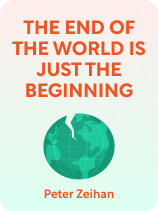

This article is an excerpt from the Shortform book guide to "The End of the World Is Just the Beginning" by Peter Zeihan. Shortform has the world's best summaries and analyses of books you should be reading.
Like this article? Sign up for a free trial here.
How is global trade connected to various aspects of life? How might countries cope if international shipping suddenly became unreliable?
In The End of the World Is Just the Beginning, Peter Zeihan’s predictions signal a dramatic shift in the global economy. He foresees a world where declining populations and trade disruptions lead to widespread economic turmoil, energy shortages, and food scarcity.
Keep reading to learn what Zeihan believes is in our future.
Peter Zeihan’s Predictions
According to Peter Zeihan, the most pressing threat to civilization is the impending collapse of international trade (what he calls “deglobalization”). In his book, he predicts that a demographic implosion will trigger a crisis in global trade that spells worldwide economic disaster, energy shortages, political turmoil, and famine. Here’s a synopsis of Peter Zeihan’s predictions and his rationale:
- Declining populations in the developed world will trigger economic crises around the globe.
- As the world’s population and economy shrinks, the delicate balance of globalized trade will start to come apart at the seams. Zeihan warns that, if the US stops protecting international shipping, then vital trade routes will be vulnerable to local wars and international piracy. Transporting goods will be hazardous again, and the reliable flow of trade between countries could suddenly come to a halt.
- If global trade retracts, the world is likely to break apart into regional economies where every commodity is lower in quality and more expensive than it was during globalization. The countries most dependent on imports and exports will take military action to secure their shipping lanes.
- While every commodity will be affected by restrictions on international shipping, those restrictions will compound themselves by limiting access to the resource that makes global transportation possible—oil. If international shipping falls apart, oil production will be drastically reduced, triggering an energy crisis.
- Feeding people depends on cheap, reliable shipping, and, if that fails, so does the food supply. Zeihan predicts that breakdowns in food production will lead to mass starvation, death, and the fall of governments.
Though the problems coming our way may be unpleasant to think about, finding a way through them is even more difficult. Zeihan attempts to do so by focusing on the most basic needs that nations have to fulfill, including acquiring enough resources and food to keep people going through the lean times ahead.
Zeihan argues that, of all the world’s countries, the US is uniquely positioned to weather the storms of deglobalization. The US has more high-quality farmland than any other country, which will serve it well in the trying times to come. Thanks to fracking technology that lets the US drill for shale oil, as well as an abundance of land that’s ideal for solar and wind power, the US has lower energy prices than any other country. Moreover, thanks to the geographic barriers of two oceans and its strong economic ties with its only two neighbors (Canada and Mexico), the US is essentially invasion-proof against other rival states that may envy its resources.
(Shortform note: Even if Zeihan’s right that the US would do better during deglobalization than other countries, the US would still suffer in several ways. Moving the production of goods back to the States would increase manufacturing costs, since companies originally outsourced those jobs to reduce overall expenses. This shift would drive up prices for consumers and potentially jeopardize millions of American jobs. Closing US markets to foreign competition would also reduce incentives to innovate, further weakening the US’s ability to compete on the global stage. Additionally, as trade barriers rise, the US will find it harder to access foreign markets, limiting its economic growth that’s historically been driven by international trade.)
Extreme Resource Management
Zeihan writes that many of the assumptions the modern world rests on won’t apply any longer in the near future. Chief among these is the belief that vital resources can be imported from anywhere else in the world at little cost. In the future, countries will struggle to maintain their supply lines, with varying degrees of success, and while the US and its neighbors may be able to do so, other countries—particularly China—may find themselves in serious trouble.
In a deglobalized world, countries will have to find new ways to obtain and manage the resources they need. Those blessed with the right geography and climate may be able to fuel and feed themselves internally, while others might survive by using their highly skilled knowledge base to export expertise instead of physical goods. However, Zeihan insists that supply and manufacturing chains will have to be local. Some countries may lose their industrial base entirely, with potentially disastrous humanitarian consequences.
(Shortform note: Supply chain breakdowns already occur for a variety of reasons, and foreign policy experts are working on a multi-pronged approach to deal with them. Making supply chains local, as Zeihan suggests, can reduce dependence on imports, but experts believe that strategy should be targeted only at critical sectors, such as industries vital to public health. Meanwhile, digital tracking can help identify bottlenecks in global transportation, and enforcing antitrust policies can combat noncompetitive practices that make supply chain problems worse. While completely decoupling from global trade isn’t feasible in many industries, diversifying supply chains and increasing local production can fortify industries against future disruptions.)
West Versus East
Zeihan suggests that the North American Free Trade Agreement (NAFTA) may prove to be the Western Hemisphere’s saving grace. In terms of food, manufacturing, and raw materials, the Americas (both North and South) can survive as a fairly self-contained system. Between them, the US and Mexico have an outstanding capacity for renewable energy generation, and their relatively stable demographics will soften the blow of the population plunge that Zeihan expects to shake the rest of the world. The key will be for the US, Mexico, and Canada to establish even stronger economic and demographic ties, while reestablishing the robust manufacturing base that the US let slide during the years of globalization.
(Shortform note: The US isn’t the only superpower that’s shoring up its economic supply lines. In Battlegrounds, McMaster describes the Chinese government’s One Belt One Road (OBOR) initiative as an attempt to assert China’s economic dominance. OBOR funnels vast amounts of money into foreign infrastructure development, including ports and transportation improvements to tie other countries to Chinese imports and exports. According to McMaster, OBOR projects come with many strings attached, such as high interest rates, political concessions, and bribes paid to high-ranking officials. McMaster argues that One Belt One Road is a form of economic colonialism designed to elbow the US and its allies out of world markets.)
On the other hand, Zeihan firmly believes that China faces a catastrophic collapse. At present, China is financially overextended, is entirely reliant on globalized trade, and is about to go through a demographic meltdown. If globalized trade ceases to function, and China can’t import enough energy, food, or manufacturing resources, its economic and industrial foundations will shatter, and its people will suffer. China’s downfall will cascade into major economic crises throughout the world, but it may also create opportunities for still-developing countries to establish themselves as centers of manufacturing and commerce.
(Shortform note: Several indicators point to a looming economic crisis in China, including two that Zeihan doesn’t mention—underemployment and real estate woes. As of this writing, China’s unemployment rate for young adults has risen to over 20%, with roughly half of college graduates returning home due to not being able to find jobs. At the same time, China’s real estate sector, which makes up almost a quarter of the country’s GDP, is struggling as major property developers have defaulted on over $100 billion in bonds. Local Chinese governments rely heavily on the real estate market as a source of funding, so a downturn in that industry could translate into greatly reduced public services for all.)
Feeding the World to Come
Sadly, manufacturing and economic worries may pale in comparison to the main danger that the end of globalization represents—that there might not be enough food to go around. Zeihan explores some options countries might take to secure enough food, though some of them aren’t pleasant, such as ceding control to wealthier nations or taking a giant leap back to the days of agrarian, subsistence farming.
As international trade unravels, how well countries can feed their people will determine how much chaos and human misery they’ll experience. According to Zeihan, only a handful of countries are capable of being completely self-supporting. Those that can’t grow the food they need will either go hungry or risk becoming vassals to any agricultural superpower that’s able and willing to feed them. No matter what, too many populations have grown beyond what local agriculture can support, and in the worst-case scenario, billions of people will face famine and starvation. There’s hope in new technologies, including AI-based crop management, but Zeihan thinks it’s unlikely that massive agricultural breakthroughs will happen soon enough.
Another option we mentioned earlier is to force people out of their cities and back to working on farms. Zeihan writes that the days of specialized agriculture will end, since countries will have to go back to the basic staples they need to feed their own people. While this may help some countries survive, they’ll be much poorer than they are today because they won’t be growing the cash crops that are profitable under globalization. Wealthier countries will feel the pinch in the form of fewer options in grocery stores, but for poor countries, the result will be a rollback to subsistence farming.
Finding the Future
If Zeihan’s forecasts for the future seem bleak, that’s because they are. The old rules of government, society, and trade will no longer work in the post-globalized era, and our transition into the future will be bumpy. Zeihan makes some guesses about what the post-globalized world will be like—countries and people will make do with less, old alliances will reshuffle, and new solutions to old problems will emerge.
As the world moves away from globalization, we’re about to enter a time of vast upheaval, and what political and economic realities may emerge once the turmoil is over remains uncertain. If the US holds its own, as Zeihan predicts, we can expect many people from all over the world to want to immigrate. Unfortunately, no matter which nations are best at adapting to the world’s new conditions, everyone will have to figure out how to get by using fewer resources. The world of the future will likely be defined by fractured alliances and lower standards of living, while national economies will simply have to cope with a smaller workforce than before.
(Shortform note: Zeihan’s future worst-case scenario presumes a precipitous population decline at some point over the next few decades due to regional wars, poverty, and famine resulting from economic catastrophes. Current population trends don’t reflect this, with the world’s population estimated to peak at over 10 billion by 2100, with Africa experiencing the fastest growth despite expected drops in fertility rates. Nevertheless, Europe and China are expected to see a drop in population by 2050 as older generational cohorts pass away. Until then, many countries will face the strain of an inverted population pyramid in which the middle-aged and elderly outnumber the young.)
However, Zeihan is hopeful that the pains of shifting to new world realities won’t mean the end of civilization. While the 2020s and ’30s won’t be pleasant, Zeihan believes that, by the 2040s, we’ll have achieved a new global equilibrium for agriculture and trade. Given the history of technological progress, he has no doubt that new solutions will arise to solve many of the oncoming problems, especially for energy generation and food production. Nevertheless, the inequalities between the countries that do well to survive and those that don’t will be stark. Whatever happens, Zeihan says that our Golden Age of cheap trade and international interdependence will be over.
(Shortform note: In general, Zeihan downplays the potential for technology to cope with the problems he presents, but others are more optimistic. In The Future Is Faster Than You Think, Peter H. Diamandis and Steven Kotler explain that technological progress doesn’t merely advance—it accelerates as breakthroughs in different fields merge and complement each other, amplifying their power to reshape society. For instance, the agricultural industry is pioneering ways to feed a growing population by combining advances in resource efficiency, genetic engineering, and “vertical farming” within urban centers. If these and other advances keep pace with the challenges on our horizon, the future may not be as bleak as Zeihan fears.)

———End of Preview———
Like what you just read? Read the rest of the world's best book summary and analysis of Peter Zeihan's "The End of the World Is Just the Beginning" at Shortform.
Here's what you'll find in our full The End of the World Is Just the Beginning summary:
- Why the golden age of international trade is about to end
- Why the collapse of international trade is the biggest threat to civilization
- How to prepare for tumultuous decades to come






